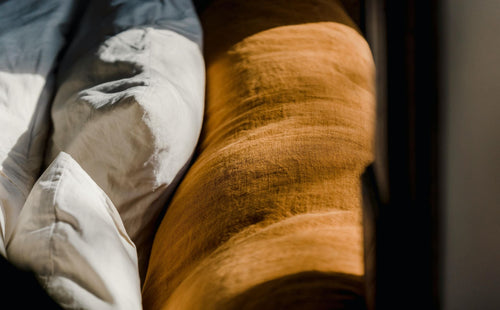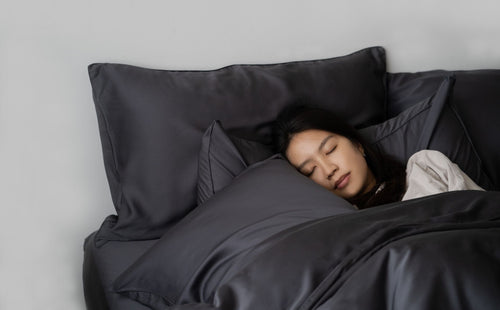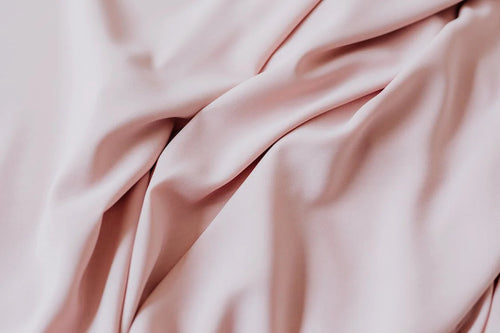
Image By ready made From Pexels
Have you ever felt excited about your brand new sheets and gotten frustrated upon seeing them bobble over time? Many people encounter this common problem called bed sheet pilling. Those tiny pieces of fuzzy fabric creating lint balls usually appear after repeated use, washing, and drying.
Pilling bed sheets look flimsy and unpleasant - probably not the kind of sight you’d look forward to during bedtime. Not to mention that such materials could feel itchy and irritating.
There are various reasons why this happens. And while fabric fraying is normal, there are ways to prevent pilling or at least minimise or slow down the process.
Some bedding materials are also less likely to bobble and have a longer lifespan than others. In this article, we’ll discuss each of these in detail!
Why Do Sheets Pill?
Mainly caused by friction, bed sheet pilling happens when the fabric is rubbed against another surface. This causes the fibres of the fabric to wear and tear.
Pilling is observed on many different types of bedsheets, typically near the foot of fitted sheets where a lot of rough movement occurs when sleeping. This makes the fibres become loose and twisted up, which will then result in little knots.
Several factors contribute to sheet bobbling, some of which are:
Poor Weave Method
Inferior weaving methods, such as having loose weaves can result in the fabric being easily twisted up. It also means that the structure of the sheet is weaker due to improper weave methods, speeding up the pilling process.
Percale and sateen weave are among the popular weaving techniques. Percale creates a tightly woven fabric whereas sateen gives that buttery-smooth feel with a subtle luminous finish. Sateen sheets are inherently wrinkle-resistant so constant ironing is the least of your worries.
Short Fibres
Featuring Weavve’s Extra Long Staple Cotton Sheets
When clusters of short fibres tangle together, pilling forms on sheets. Micro-threads are most likely to break than longer ones. This is because shorter fibres obtain more yarn ends. In effect, they are less secure in the thread yarn because they can become dislodged and knot up with other loose fibres.
When choosing bedding sheets, take into consideration the fiber length as well.
Low Thread Count
Cheap and poor-quality bed sheets are usually made with thicker yarns. Hence, fewer threads per inch and a coarser feel.
Meanwhile, a high thread count means that your sheets have a smaller chance to pill. The threads are usually made longer and are woven extremely tightly together. This will result in lesser movement, helping keep the frayed fabric at bay.
However, beware of overly high thread counts reaching 1,000 and above as they are mostly driven by heavy marketing.
Intense Heat And Chemicals
Sheets that are exposed to high heat and chemicals can result in unsightly knots. Such harsh conditions can damage the fibres.
Excessive Abrasion

Image By Andrea Piacquadio From Pexels
High amounts of friction caused between the fabrics will cause the fibres to wear away. Factors like the stubble from shaved body hair on backs and legs can be abrasive enough to generate enough friction to cause bobbling.
How To Prevent Sheets From Pilling
Every time we use our bedding sheets, we put stress on them, therefore pilling is always a possibility. But there are ways to keep the fibres from breaking and tangling sooner than they should.
Slight pilling is normal, especially after a few trips to the washer and dryer. But having a proper care routine for your fitted sheets will always do wonders to retain the feel and quality of the material. Here are tips to ensure that they do not pill easily.
Before Washing
- Sort your laundry by fabric texture, distinguishing between rougher or harder fabrics and delicate ones. This thoughtful approach ensures that each item receives the appropriate care it deserves. Moreover, flip your sheets inside out before washing to minimise abrasion on the outer surface, preserving colors and fabric texture.
- Avoid overloading the washing machine. Sheets require ample space to move around during the wash cycle. When the washer tub is overloaded beyond its capacity, there's limited space for movement, which can lead to damage to the fibres.
Washing Instructions
- Use cold water to wash sheets, as hot water damages the fabric faster. As mentioned, heat causes the fibres to weaken and loosen quickly.
-
Set your washing machine on a gentle cycle setting to prevent the sheets from shrinking and fading in colour. It also keeps those puff balls at bay and makes the fabric lasts longer.

Image By gokceakyildiz From Pexels
Drying Instructions
- Hang your sheets to line dry instead of using the dryer. It will reduce the wear and tear caused by the dryer’s movement. If air drying is not possible, set the dryer settings to low heat cycle. Always remember, delicate sheets like TENCEL™ Lyocell should never be tumble dried.
Then, remove the sheets immediately after the cycle ends. Be sure not to over dry them in order to retain the feel of soft bedsheets.
-
Use dryer balls to help to dry clothes faster as it tumbles in the dryer with your wet clothes. A natural alternative to dryer sheets and fabric sprays, this tightly packed dryer wool is more efficient and eco-friendly.
Featuring Weavve's Wool Dryer Ball
Detergent Products
- Avoid using harsh detergents when washing your sheets as they contain brighteners. These bleach derivatives can weaken the fibres. Instead, use a bleach-free detergent with no bleach or optical brighteners. To brighten whites, you can add 1/4 cup lemon juice to the wash cycle instead of bleach.
- If you’re looking for a plastic-free alternative to your traditional laundry detergent, an eco-friendly or enzyme-based detergent is the way to go.
Bonus Tips
- By regularly using a lint roller, you can effectively prevent knots and pills from building up on the surface, preserving their smooth and clean appearance.
- You can also use a fine-mesh bag to serve as a physical barrier as it shields your bedding from friction during washing. This helps ensure that they remain undamaged and looking their best.
How To Remove Pilling From Sheets
Many are asking how to get rid of pilling on sheets. Simply snip away the tiny balls of fabric with a small pair of scissors or a clothes shaver if your sheets do start to pill.
Some would advise using a razor and shave to scrape off the fuzz. Lastly, as mentioned above, you may also opt for a lint roller.
But if you want to save yourself the trouble, again, it boils down to selecting smooth bedsheets.

Featuring Weavve’s Signature TENCEL™ Classic Set In Slate Grey
Bed Sheet Materials That Are Less Prone To Pilling
Some fabrics are stronger than others. Here are some of the materials of bed sheets that are less likely to become shabby:
Long-Staple Cotton
Cotton is often susceptible to pilling. However, it generally depends on the staple length and quality of the cotton used.

Featuring Weavve’s Cotton Classic Set In Persian Grey
Some types of cotton bed sheets, such as Pima and Egyptian cotton, are known to be durable. They’re both extra-long staple cotton that hardly bobbles if properly taken care of. Such cotton bed sheet fabrics are usually high in quality and cost.
Be careful not to fall into false advertisements as some may be marketed as “100% Long-Staple Egyptian cotton” though low-quality cotton sheets were used.
TENCEL™

Featuring Weavve’s Signature TENCEL™ Classic Set In Midnight Blue
Pilling is a common concern with fabrics, and while some are more resistant, others aren't as much. TENCEL™ Modal, for example, is praised for its ability to resist pilling due to how it's made. However, pure TENCEL™ Lyocell fabric might be more susceptible to pilling.
While TENCEL™ Lyocell is known for its durability and strength, it can also be delicate and might need special upkeep. Following the care guide and instructions is key to keeping the fabric in top condition.
Silk
Featuring Weavve’s Silk Pillow
Silk is made of natural long fiber. This means that it hardly pills if it is properly taken care of. In terms of qualities, silk and TENCEL™ have a lot in common though silk bed sheets are more expensive and less ethical in their production methods.
Linen
Linen does not pill easily as it has long fibres. One main reason that linen is not as popular as TENCEL™ or cotton is because it is not as smooth and soft as them.
Both linen and TENCEL™ are ideal for hot sleepers. However, linen is prone to wrinkling, unlike other long-lasting fabrics.
Bamboo
In order to strengthen the fibres and make sure to keep the fabric smooth, bamboo sheets are typically woven in fabric. Bamboo bed sheets in Singapore are resistant to pilling because the fibres are locked in by the tight diagonal twill weave.








































